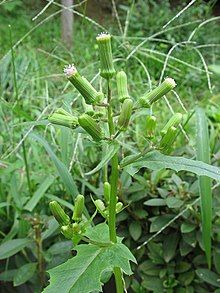Erechtites hieraciifolius
| Erechtites hieraciifolius | |
|---|---|

| |
| Photo taken in Tokyo, Japan | |
| Scientific classification | |
| Kingdom: | Plantae |
| Clade: | Tracheophytes |
| Clade: | Angiosperms |
| Clade: | Eudicots |
| Clade: | Asterids |
| Order: | Asterales |
| Family: | Asteraceae |
| Genus: | Erechtites |
| Species: | E. hieraciifolius
|
| Binomial name | |
| Erechtites hieraciifolius | |
| Synonyms[2] | |
|
Synonymy
| |
Erechtites hieraciifolius (fireweed, American burnweed, or pilewort) is a plant in the daisy family, Asteraceae.[3] It is native to the Americas,[4] but is found many places around the world having been introduced by human activity.[5] such as in Hawaii, China, Europe and Southeast Asia.[6][7]
Description
[edit]Erechtites hieraciifolius is an annual herb with alternate, simple leaves, on thick, green stems. The leaves are serrated, and range from unlobed to deeply lobed, with the lobe pattern superficially resembling wild lettuces, which are in the same family but not closely related. When crushed, all parts of the species are aromatic. The flower heads are yellow or pink, borne in fall. The heads are followed by cluster of small, wispy achenes. The plant often branches and grows in a clump with multiple stems.[4]
Ecology
[edit]This species benefits from fire, and is often one of the earliest pioneer species of areas that have recently burned, hence some of its common names. It prefers moist sites but can handle gravelly soil and some degree of dry conditions. It also grows well in urban areas and around humans.[4]
The flowers are pollinated primarily by wasps and honey bees (Apis mellifera). The seeds are wind-dispersed, and are used as a minor food source by birds.[6]
References
[edit]- ^ a b c d International Code of Nomenclature for algae, fungi, and plants (Melbourne Code) see sections 60C.1 and 60G.1
- ^ The Plant List, Erechtites hieraciifolius (L.) Raf. ex DC.
- ^ "Erechtites hieraciifolius (L.) Raf. ex DC. | Plants of the World Online | Kew Science". Plants of the World Online. Retrieved 2024-11-15.
- ^ a b c "Erechtites hieraciifolius (Linnaeus) Rafinesque ex de Candolle". Flora of North America.
- ^ "Erechtites hieraciifolius (L.) Raf. ex DC". Pacific Island Ecosystems at Risk (PIER).
- ^ a b United States Department of Agriculture Plants Profile for Erechtites hieraciifolia
- ^ Flora of China, 梁子菜 liang zi cai, Erechtites hieraciifolius (Linnaeus) Rafinesque ex Candolle
External links
[edit]- United States Department of Agriculture Plants Profile
- photo of herbarium specimen at Missouri Botanical Garden, collected in Brazil in 1964
- photo of herbarium specimen at Missouri Botanical Garden, collected in Peru in 1986
- photo taken by Gerrit Davidse, showing one specimen of Homo sapiens beside one specimen of Erechtites hieraciifolius
![]() Media related to Erechtites hieraciifolia at Wikimedia Commons
Media related to Erechtites hieraciifolia at Wikimedia Commons
